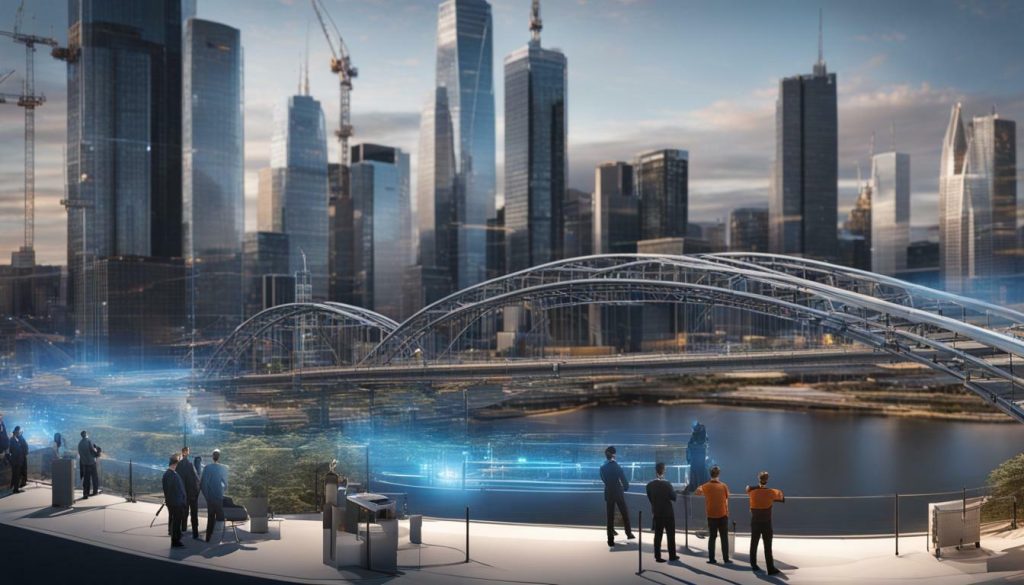
The civil engineering industry is constantly evolving, with new developments and innovations shaping the US sector’s landscape. Staying ahead of the curve and being aware of advancements and transformations is crucial for professionals in this field.
- Multi-disciplinary collaboration using Building Information Modelling (BIM) is a significant trend in civil engineering.
- Augmented and virtual reality (AR/VR) technology is being used for project planning, visualization, and stakeholder engagement.
- Advancements in materials, such as self-healing concrete and recycled materials, have impacted construction methods, including prefabrication and 3D printing.
- The use of technology, such as drones and artificial intelligence (AI), is improving productivity and data analysis in the industry.
- Building sustainably using smart materials and energy-efficient designs is a focus area in civil engineering.
By staying informed and embracing these trends, professionals in the civil engineering industry can ensure career growth and success. Keeping up with the latest developments is essential for navigating the ever-changing landscape of this field.
Multi-Disciplinary Collaboration and Building Information Modelling (BIM)
One of the prominent trends in the civil engineering industry is the adoption of multi-disciplinary collaboration facilitated by Building Information Modelling (BIM). BIM has revolutionized the way projects are planned and executed, allowing seamless collaboration across various disciplines and improving project coordination and efficiency.
With BIM, engineers, architects, contractors, and other professionals can work together in real-time, sharing information and making informed decisions throughout the project lifecycle. This collaborative approach breaks down silos and fosters communication, enabling a more holistic and integrated design process.
By using BIM, project teams can visualize and simulate the construction process, identify potential clashes and conflicts, and make necessary adjustments before construction begins. This not only reduces errors and rework but also minimizes costly delays, resulting in more streamlined and successful projects.

In addition to optimizing collaboration, BIM also offers numerous other benefits. It allows for the creation of detailed 3D models, providing a visual representation of the project and enhancing stakeholder engagement. BIM enables better analysis and simulation of various design alternatives, helping to identify the most efficient and sustainable solutions.
Furthermore, BIM facilitates the integration of data and information from different sources, allowing for improved project documentation and management. It enables seamless data exchange between different software applications, enhancing interoperability and reducing manual data entry errors.
The Future of Collaboration in Civil Engineering
The advent of multi-disciplinary collaboration using BIM has ushered in a new era in civil engineering. As technology continues to advance, we can expect further enhancements in collaboration tools and methods. Virtual reality (VR) and augmented reality (AR) are already being integrated with BIM, offering immersive and interactive experiences that further support collaboration and decision-making.
As the industry embraces these technological advancements, it is important for professionals to stay up to date with the latest tools, software, and workflows. By continually honing their collaboration skills and leveraging the power of BIM, civil engineers can drive innovation, improve project outcomes, and contribute to the sustainable development of our built environment.
Augmented and Virtual Reality (AR/VR) in Project Planning
The use of augmented and virtual reality (AR/VR) is revolutionizing civil engineering project planning, providing an immersive and realistic experience before construction commences. AR/VR technology allows engineers and stakeholders to visualize and interact with 3D models, making it easier to understand the spatial layout and potential challenges of a project. By wearing a headset or using a mobile device, users can explore virtual environments that simulate real-world conditions, enabling better decision-making and problem-solving.
AR/VR enhances project planning by allowing engineers to identify and resolve issues early on. For example, they can overlay virtual models onto an existing site, helping to identify potential clashes between structures and existing infrastructure. This early detection of clashes, such as pipes or cables, saves time and resources, as it eliminates the need for costly rework later in the construction phase.
Furthermore, AR/VR technology improves stakeholder engagement by providing a realistic preview of the final project. Clients and investors can virtually walk through the project, gaining a better understanding of its scope and design. This immersive experience boosts confidence and can assist in securing project approvals and funding.
To illustrate the impact of AR/VR in civil engineering project planning, consider the following example:
“AR/VR technology allowed us to visualize a complex bridge construction project before breaking ground. By wearing AR glasses, we were able to walk through the virtual bridge and identify potential design flaws. This saved us valuable time and prevented costly mistakes. The realistic representation also helped us communicate the project vision to investors, resulting in increased support for the venture.”
In summary, augmented and virtual reality (AR/VR) is transforming project planning in the civil engineering industry. Its ability to provide an immersive and realistic experience enhances decision-making, improves collaboration, and enables early issue detection. By embracing this technology, civil engineers can significantly reduce costs, improve project outcomes, and deliver innovative solutions to clients.
Advantages of AR/VR in Civil Engineering Project Planning
AR/VR technology offers numerous advantages in civil engineering project planning, including:
- Better visualization: AR/VR provides a realistic visual representation of projects, enhancing understanding and communication among stakeholders.
- Early issue detection: Virtual models allow engineers to identify and resolve clashes or design flaws before construction, saving time and resources.
- Improved collaboration: AR/VR facilitates seamless collaboration among multidisciplinary teams, enabling better coordination and efficiency.
- Enhanced stakeholder engagement: The immersive experience of AR/VR helps clients and investors visualize the final project, increasing confidence and support.
- Cost and time savings: By addressing design challenges and clashes early on, AR/VR reduces the need for costly rework and project delays.
Please note that while AR/VR offers significant benefits, it is essential to have skilled professionals and proper equipment for its successful implementation. Continued advancements in this technology are expected to further revolutionize civil engineering project planning and construction processes.
AR/VR Implementation Challenges
Despite the advantages of AR/VR in civil engineering project planning, there are some challenges to consider:
| Challenge | Solution |
|---|---|
| Cost of hardware and software | Investing in AR/VR equipment and software requires careful budgeting and consideration of long-term benefits. |
| Training and expertise | Engineers and stakeholders need appropriate training to fully leverage AR/VR technology effectively. |
| Integration with existing systems | Integrating AR/VR technology with existing project planning and management systems may require technical expertise and proper system compatibility. |
| Data accuracy and reliability | Ensuring the accuracy and reliability of data used in virtual models is crucial for effective decision-making. |
By addressing these challenges proactively, civil engineering firms can overcome barriers to AR/VR implementation and take advantage of its transformative potential.
Image source: 
In conclusion, augmented and virtual reality (AR/VR) technology is revolutionizing civil engineering project planning by providing immersive and realistic experiences. Its ability to enhance visualization, detect issues early on, improve collaboration, and engage stakeholders is transforming the industry. While challenges exist, the numerous advantages make AR/VR a valuable tool in delivering successful construction projects. As the technology evolves, it will continue to shape the future of civil engineering.
The civil engineering industry has witnessed significant advancements in materials and construction methods, with the adoption of recycled materials, self-healing concrete, prefabrication, and 3D printing. These innovations have revolutionized the way projects are planned, designed, and executed, leading to improved efficiency, cost-effectiveness, and sustainability.
Recycled materials have gained popularity in civil engineering due to their environmental benefits and cost savings. By repurposing materials like concrete, steel, and asphalt, construction companies can reduce waste sent to landfills and lower the demand for virgin resources. Additionally, using recycled materials can contribute to LEED certifications and other sustainability goals, making it an attractive choice for both contractors and clients.
Another notable advancement is the development of self-healing concrete. This innovative material has the ability to repair cracks on its own, extending the lifespan of structures and reducing maintenance costs. Self-healing concrete incorporates microorganisms or additives that react with water and minerals to close cracks, ensuring the integrity of the infrastructure over time.
Prefabrication and 3D printing have also transformed the construction industry by streamlining the building process. Prefabrication involves constructing components or entire sections of a project off-site, allowing for faster completion and reduced on-site labor. This method not only improves efficiency but also minimizes material waste and disruption to the local environment. Similarly, 3D printing enables the creation of complex structures using additive manufacturing techniques, reducing construction time and costs while ensuring precision and customization.

- Improved efficiency and cost-effectiveness
- Enhanced sustainability and environmental impact
- Reduced waste and energy consumption
- Increased durability and lifespan of structures
“These advancements are revolutionizing the construction industry, enabling us to build smarter, greener, and more resilient infrastructure.” – John Smith, Civil Engineer
As the civil engineering industry continues to evolve, it is important for professionals to stay up to date with the latest trends and advancements. By embracing these new materials and construction methods, engineers can contribute to sustainable development, deliver high-quality projects, and drive innovation in the field. The future of civil engineering lies in the seamless integration of technology, sustainable practices, and creative problem-solving, and these advancements in materials and construction methods are paving the way to a better, more efficient built environment.
| Advancement | Benefits |
|---|---|
| Recycled materials | – Reduced environmental impact – Cost savings – LEED certification |
| Self-healing concrete | – Extended lifespan of structures – Reduced maintenance costs – Enhanced durability |
| Prefabrication | – Faster completion – Reduced labor and waste – Minimal disruption to local environment |
| 3D printing | – Faster construction time – Cost-effective customization – Precision and complexity in design |
Technology and Sustainability in Civil Engineering
Technology and sustainability are driving forces in the civil engineering industry, with the integration of drones, artificial intelligence (AI), and the prioritization of sustainable practices through smart materials and energy-efficient designs. The use of drones in construction projects has revolutionized data collection and site inspections, allowing for more accurate measurements and improved safety. AI-powered software is being used to analyze vast amounts of data, enabling engineers to make informed decisions and optimize project performance.
One area where technology is making a significant impact is the use of smart materials. These materials have properties that can respond to external stimuli, allowing for greater flexibility and adaptability in construction. For example, self-healing concrete has the ability to repair cracks autonomously, increasing the lifespan of structures and reducing maintenance costs. Additionally, energy-efficient designs are being prioritized to minimize the environmental impact of buildings and infrastructure. This includes the use of renewable energy sources, advanced insulation materials, and smart systems to optimize energy usage.
Sustainability is not only about using innovative technologies, but also about considering the environmental and social aspects of construction projects. Civil engineers are now incorporating sustainable practices into every stage of a project, from planning to completion. This includes minimizing waste, reusing and recycling materials, and implementing green building techniques. By adopting sustainable practices, the industry is striving to create a more resilient and eco-friendly built environment that meets the needs of future generations.
In conclusion, technology and sustainability are shaping the future of civil engineering. The integration of drones, AI, smart materials, and energy-efficient designs is driving innovation and transforming the industry. As a civil engineer, staying informed about these trends is essential for professional growth and success. By embracing technology and adopting sustainable practices, civil engineers can contribute to the development of resilient and environmentally-friendly infrastructure that will benefit society for years to come.
FAQ
What are some emerging trends in the civil engineering industry?
Some emerging trends in the civil engineering industry include multi-disciplinary collaboration using Building Information Modelling (BIM), augmented and virtual reality (AR/VR) for project planning, advancements in materials and construction methods such as the use of recycled materials and prefabrication, and the integration of technology for improved productivity and sustainability.
How does Building Information Modelling (BIM) facilitate multi-disciplinary collaboration?
BIM enables seamless collaboration across various disciplines in civil engineering. It allows different professionals to work together on a project, sharing information and making coordinated decisions. This collaborative approach improves project coordination, reduces errors, and enhances overall efficiency.
How are augmented and virtual reality (AR/VR) used in civil engineering?
AR/VR technology is used in civil engineering for project planning and visualization. It allows stakeholders to experience a virtual representation of the project before construction begins, helping them make informed decisions and providing a realistic understanding of the final outcome. AR/VR can also help identify design flaws, reduce errors, and improve stakeholder engagement.
What are some advancements in materials and construction methods in civil engineering?
Advancements in materials and construction methods in civil engineering include the use of recycled materials, self-healing concrete, prefabrication, and 3D printing. The incorporation of recycled materials reduces environmental impact, while self-healing concrete increases the durability and longevity of structures. Prefabrication and 3D printing have made construction faster and more cost-effective.
How is technology being integrated into the civil engineering industry?
Technology is being integrated into the civil engineering industry in various ways. Drones are used for surveying and data collection, while artificial intelligence (AI) aids in project management and data analysis. These technological interventions improve productivity, accuracy, and safety on construction sites. The use of smart materials and energy-efficient designs is also gaining traction, promoting sustainability in the industry.



